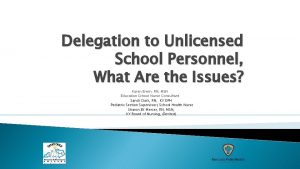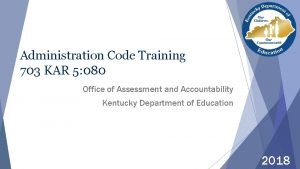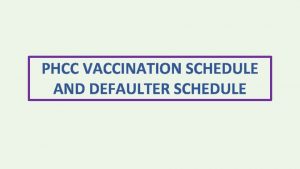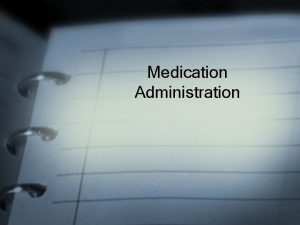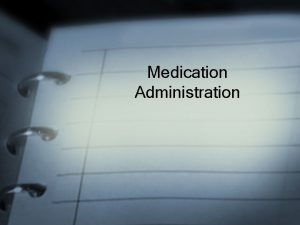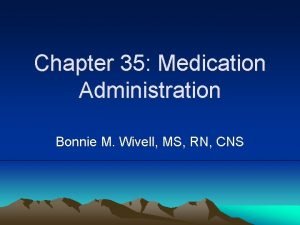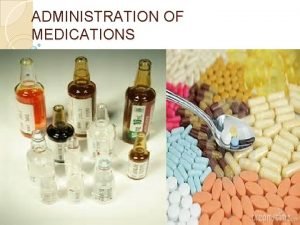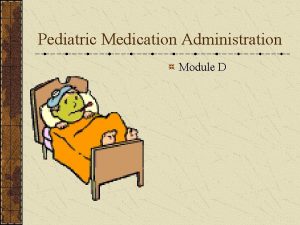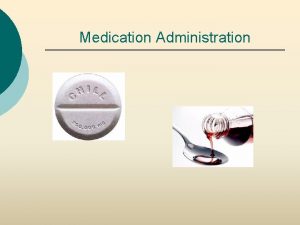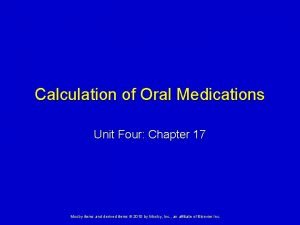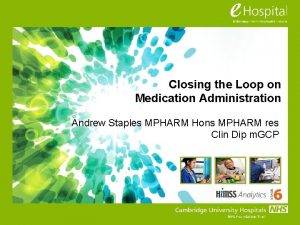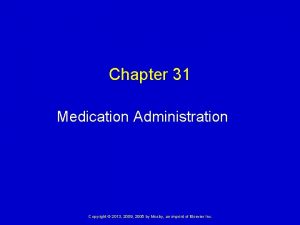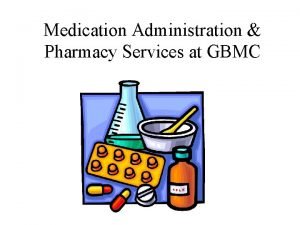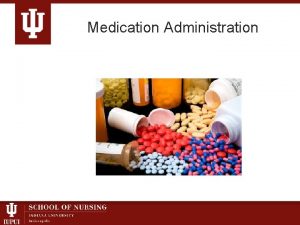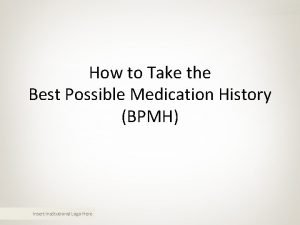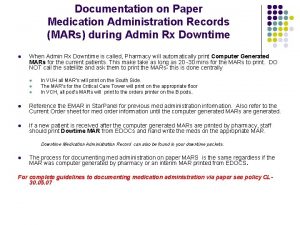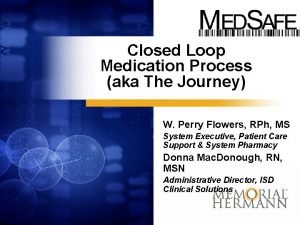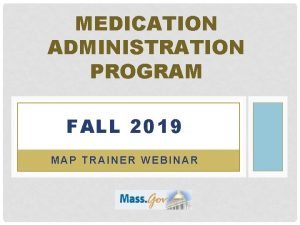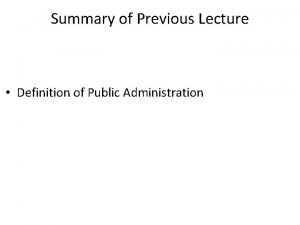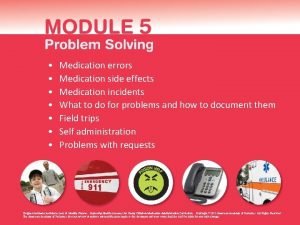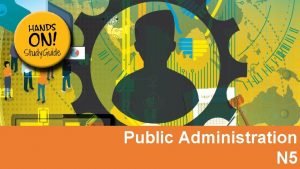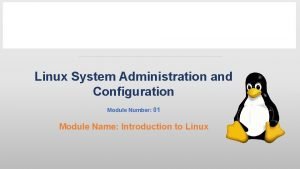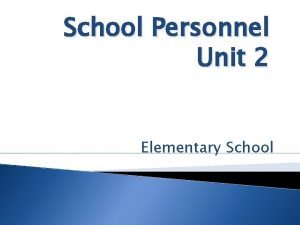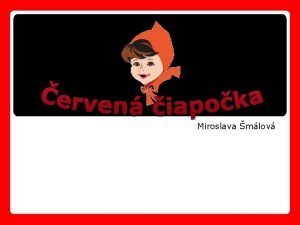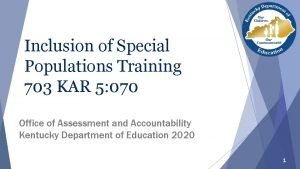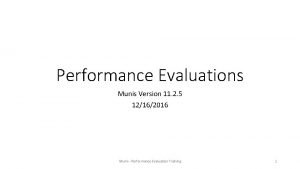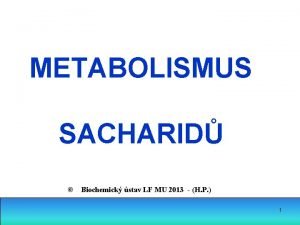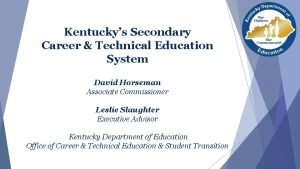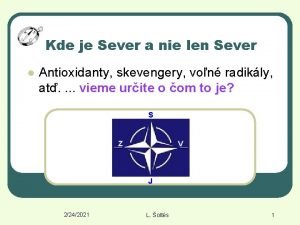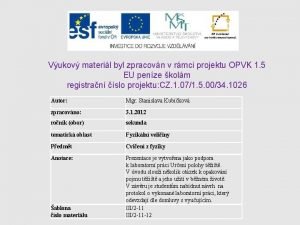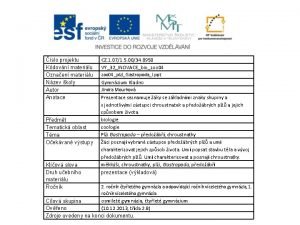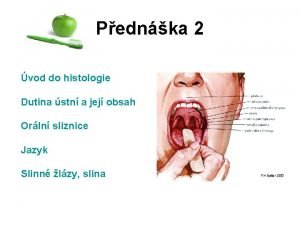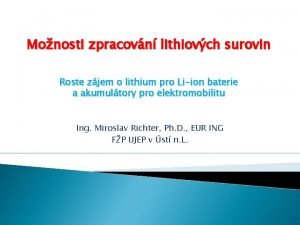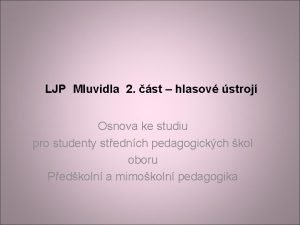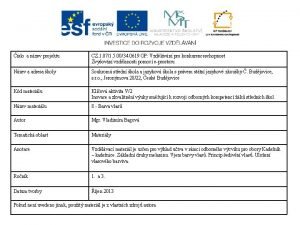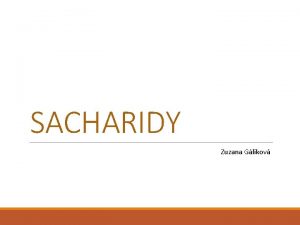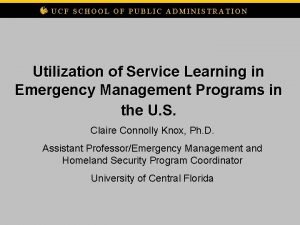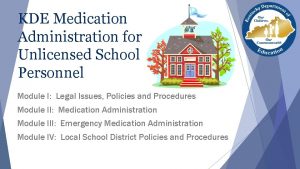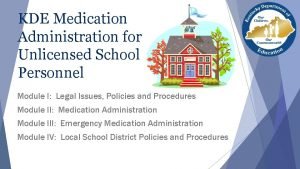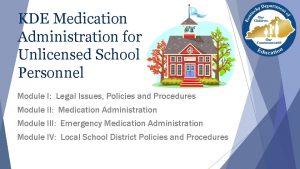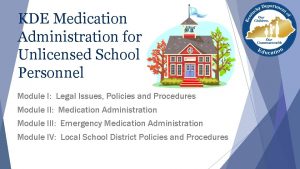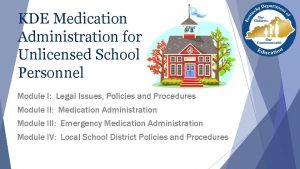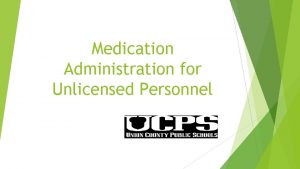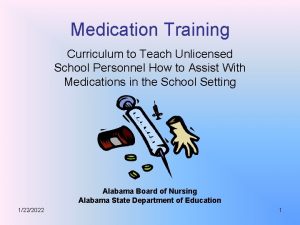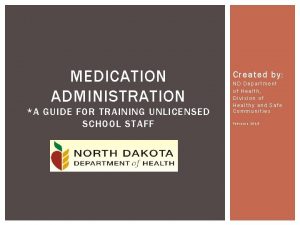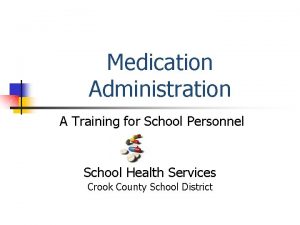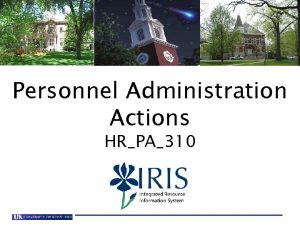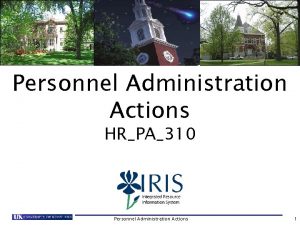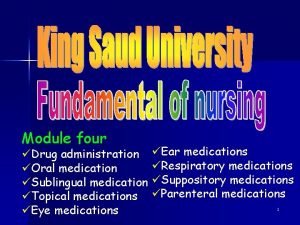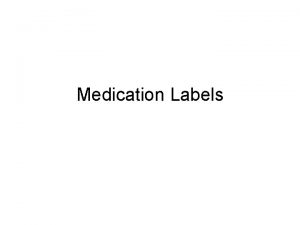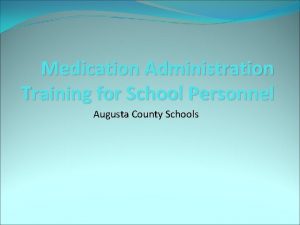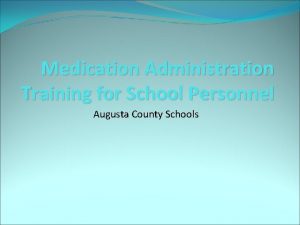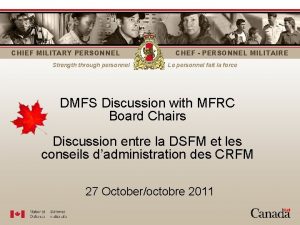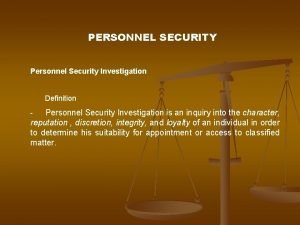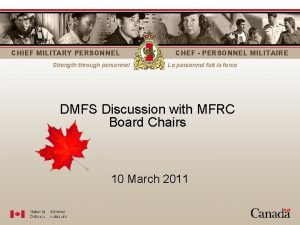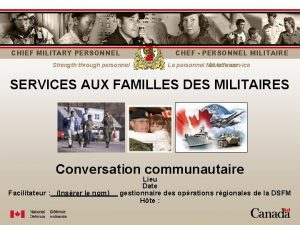KDE Medication Administration for Unlicensed School Personnel Module



































































































- Slides: 99

KDE Medication Administration for Unlicensed School Personnel Module I: Legal Issues, Policies and Procedures Module II: Medication Administration Module III: Emergency Medication Administration Module IV: Local School District Policies and Procedures

Kentucky Department of Education Office of Finance and Operations Division of District Support Services 300 Sower Blvd. , 4 th floor Frankfort, KY 40601 (502) 564 -5279 Wayne D. Lewis, Ph. D, Commissioner Kentucky Department of Education Revised April 2019

ACKNOWLEDGEMENT } Kentucky Department of Education (KDE) recognizes the need for a uniform medication administration training program for unlicensed school personnel } Developed collaboratively between the KDE, the Kentucky Department for Public Health (KDPH) and in consultation with the Kentucky Board of Nursing (KBN) } Compliance 201 KAR 20: 400 ● KRS 156. 502 ● 702 KAR 1: 160 ● } Curriculum is the official training program for all unlicensed Kentucky public school personnel who accept delegation to perform medication administration

Course Objectives Upon completion of this course, unlicensed school personnel will be able to: Understand how medication administration may be safely delegated Identify the responsibilities of the school nurse and unlicensed school personnel in medication administration ü Understand local school board policies for medication administration ü Recognize and apply the six (6) rights of medication administration ü Identify proper storage of prescription and over-the-counter medication ü Understand appropriate and correct documentation of medication administration ü Understand proper action and documentation necessary for refusal and omission of scheduled medications ü Understand prevention of medication errors and incident reporting ü Recognize when it is appropriate to contact additional resources (nurses, physicians, poison control and emergency medical services)

Course Goals } This course is intended for non-licensed personnel who have accepted the delegation to provide medication administration to students in a school setting } 702 KAR 1: 160, Section 4(3)(g), proof that all unlicensed school personnel who have accepted delegation to perform medication administration in school have completed a training course provided by the KDE } KBN to ensure compliance with 201 KAR 20: 400 } KRS 156. 502, the delegation is only valid for the current school year

Recommended Individuals } Employing school will reserve the right to recommend individuals for this training } Upon successful completion, non-licensed school employee will demonstrate competency, as determined by the delegating Registered Nurse (RN), Advanced Practice Registered Nurse (APRN), or physician, in: Administration of student medication ● Verification of student instruction on self-administration of medications ● Administration of emergency medications for students with diabetes, allergic anaphylactic reactions and seizures ●

Course Description Four modules } Module I: Laws, Policies and Procedures } Module II: Administration of Medications } Module III: Administration of Emergency Medications } Module IV: Local School Board Policies & Procedure

Medication Administration Competency Verification Personnel will be required to score a 100% on the skill competency evaluation and 85% on an open book final exam which will include demonstration of: } Reviewing student medication history on Medication Administration Record/Medication log for documentation of allergies and other co-existing medical condition } Using proper hygiene/universal precautions in medication preparation } Accurately identify student/client medication information by comparing medication label to the transcribed Medication Administration Record/Log } Correct administration of emergency medications prescribed for the treatment of hyperglycemia, anaphylaxis, seizures and opioid overdose } Understanding of local school district policies and procedures

MODULE I: LAWS, POLICIES, AND PROCEDURES

The Family Educational Rights and Privacy Act (FERPA) (20 U. S. C. § 1232 g; 34 CFR Part 99) is a Federal law that protects the privacy of student education records } The law applies to all schools that receive funds under an applicable program of the U. S. Department of Education } Generally, schools must have written permission from the parent or eligible student in order to release any information from a student's education record. However, FERPA allows schools to disclose those records, without consent, to the following parties or under the following conditions: ● ● ● ● ● School officials with legitimate educational interest Other schools to which a student is transferring Specified officials for audit or evaluation purposes Appropriate parties in connection with financial aid to a student Organizations conducting certain studies for or on behalf of the school Accrediting organizations To comply with a judicial order or lawfully issued subpoena Appropriate officials in cases of health and safety emergencies; and State and local authorities, within a juvenile justice system, pursuant to specific State law Forum Guide to the Privacy of Student Information: A Resource for Schools (NFES 2006– 805). U. S. Department of Education, Washington, DC: National Center for Education Statistics } https: //www 2. ed. gov/policy/gen/guid/fpco/ferpa/index. html? src=rn

Laws Related to Medication Administration } Potential for unsafe administration of medication in schools or during school sponsored events poses a possible liability for schools } An understanding of state laws and school district policies and procedures is necessary to reduce the potential liability issues of medication administration in the school setting } School personnel who accept the delegation of medication administration and successfully complete this course, including demonstrated competency, are protected from liability under KRS 156. 502

Who Can Prescribe Medicine? } Only Physicians, Dentists and Advanced Practice Registered Nurses (APRN) are licensed to “prescribe” medication } Nurses are licensed to “administer” medications (KRS 314. 011) } Only registered nurses, APRNs or physicians in the school setting may delegate the task to administer medications to persons who have completed a course such as this, and have demonstrated competency (KRS 156. 502) } School personnel may be trained to administer medications that are prescribed to treat emergency or life-threatening health conditions such as hypoglycemia, anaphylaxis, seizures and opioid overdoses. KRS 158. 838, KRS 217. 186, KRS 1526. 502

School Nurse } May be either an Advanced Practice Registered Nurse (APRN), a registered nurse (RN) or licensed practical nurse (LPN) } Educational Preparedness Differences APRN ● RN and ● LPN ● } Defined in KRS 314. 011 and described in KBN AOS #30, “School Nursing Practice”

Advanced Practice Registered Nursing (APRN) Advanced Practice Registered Nurse } Designated nurse practitioner or clinical nurse specialist ● provide primary healthcare services to students in accordance with 201 KAR 20: 057 ● The APRN may also perform acts within the scope of registered nursing practice

Registered Nursing Practice Registered Nurse } Qualified by education, experience, and current clinical competence to provide school health services/acts including but not limited to the following: ● Utilize substantial, specialized nursing knowledge, judgment and skill in providing primary healthcare to students including ". . . initial assessment, management of minor illness and/or referral to other health professionals, monitoring of chronic diseases, health supervision, counseling, promotion of healthy life-styles, disease prevention, and the coordination of services when specialized care is required. " (National Association of School Nurses, Resolution--Primary Health Care, June 1981. ) ● Serve as a health advocate of students, and a consultant to educational staff ● Serve in family resource and youth services centers as defined in KRS 156. 497 ● Provide health teaching with a focus on disease prevention, health promotion and health restoration ● Monitor the quality of the healthcare services provided for students ● Provide direct clinical services for students with special needs and/or teach and verify competency, supervise and delegate [as defined in KRS 314. 011(2)] the performance of select acts to unlicensed school personnel in accordance with the administrative regulation 201 KAR 20: 400 governing delegation of nursing tasks to unlicensed persons ● Participate in the development of policies and procedures to guide nursing practice in school settings, and to address expanding school health services to students, families and communities ● Delegate select health services to a school employee in accordance with KRS 156. 502 and 201 KAR 20: 400

Licensed Practical Nursing Practice KRS 314. 011(10) Licensed practical nurses practice under the direction of a registered nurse, physician, or dentist and are not licensed for independent nursing practice The board recognizes the participation of the licensed practical nurse (LPN) in school nursing practice when the LPN is qualified by education, experience and current clinical competency and practices under the direction and delegation of a designated registered nurse, physician, or when applicable, a dentist The licensed practical nurse performs acts within the scope of licensed practical nursing practice as defined in KRS 314. 011 (10); however, under KRS 156. 502 (2) the LPN does not delegate the performance of health services to school employees

Administering Medication } The RNs may administer medications and treatments as prescribed by physicians, physician assistants, dentists and advanced practice registered nurses (APRNs) } Supervision of the LPN does not require the supervisor to be physically present in the same building. However, the LPN shall not provide nursing care in the school setting without oversight (supervision) from an RN, APRN, MD or when applicable, dentist

Different Educational Preparation } Registered Nurse practice and the Licensed Practical Nurse practice Ø Degree of educational preparation and the responsibilities of each are different • Both the RN and LPN must hold a current license from the KBN and their licenses must be renewed annually • Licensure renewal each nurse is required to complete KBN approved continuing education each year, or provide documentation of a state nursing board approved alternative ü Licensed practical nurses practice under the direction of a registered nurse, therefore they can not train or delegate to unlicensed personnel

KBN Legal Authority KBN has the legal authority (KRS 314. 021) to regulate nursing practice in order to safeguard the health and safety of citizens of Kentucky } Delegation is defined by the American Nurses’ Association “The transfer of responsibility for the performance of an activity from one individual to another, while maintaining the accountability for the outcome” ● School health services (i. e. such as the administration of medications) may be delegated to unlicensed school personnel according to related sections of KRS 156. 502 ● KRS 156. 502 describes who may delegate health service(s) (physician, APRN or RN), the training and documentation of the training ● The delegation and training is only valid for the current school year (KRS 156. 502 (2)2)

Kentucky Administrative Regulation (KAR) 201 KAR 20: 400 Delegation of nursing tasks to non-licensed personnel } Provides direction on how tasks may be delegated to a non-licensed individual by a licensed registered nurse } The delegating school nurse will also be responsible for ongoing training and competency evaluations of the non-licensed personnel to safeguard the health and welfare of the students in their care } Supervision is defined in 201 KAR 20: 400 to mean “the provision of guidance by a qualified nurse for the accomplishment of a nursing task with periodic observation and evaluation of the performance of the task” } The evaluation should include validation that the nursing task has been performed according to established standards of practice } Even when school personnel may perform the task, whoever delegates the task will retain the responsibility for the outcome } Supervision of unlicensed school personnel does not require the delegating nurse to be present in the same building. ü The delegating school nurse should be available by phone for consultation

Course Completion üUpon successful completion of this course (course exam and skill competency evaluation), the non-licensed school employee will receive a proof of completion certificate üThis in no way identifies the individual as a Certified Medication Administration Technician üThis training and competency evaluation must be renewed each school year

Role of Unlicensed Personnel in Medication Administration } KRS 156. 502 established the definition of “health services” and the provisions for who may provide health services in schools } School employees may be delegated selected health services according to KRS 156. 502

Accepting Delegation When accepting the delegation to perform medication administration in the school setting: } The unlicensed school employee performs this function under the supervision of the delegating licensed professional (KRS 156. 502) } Unlicensed school personnel should only accept a delegation that he/she knows is within his/her skill set or knowledge and should always contact the supervising school nurse if unclear about administering a medication } Unlicensed personnel have the responsibility to follow school district policies and procedures and report to the nurse if they have any reason to believe they have made a medication error Ø Errors should be reported as soon as possible

Consent to Delegate } KRS 156. 502 } Requires written documentation of the school employee’s consent to the delegation of medication administration verifying that they have received training and demonstrated competency The delegation, training and documentation are only valid during the current school year

Confidentiality and Privacy FERPA } Rights and Privacy Act (FERPA) is the federal law that protects the privacy interests of students and their educational records } Applies to any educational agency that receives funds from the United States Department of Education (USDOE) } Health records maintained by school employees for Pre-Kindergarten through grade 12 students are protected by FERPA } Information regarding student health information should be shared with school personnel only on a “need to know” basis } Health records contain sensitive information and may not be disclosed without parental/guardian permission } Certain student health information may be necessary to share with school personnel who may be assisting with medication administration. However, this information is confidential and should not be shared with other students or school employees } Privacy is a separate legal concept If a student tells school personnel how they feel about having a chronic health condition, this information should be shared with the school nurse but not disclosed to those who do not have a “need to know”

Other Legal Considerations in Medication Administration } All school districts should have written policies and procedures on medication administration } The purpose of these policies and procedures are to give guidance to the local school district employees and students } Each school district employee administering medications should be familiar with their district’s policies and procedures on medication administration

NASN } The following are accepted practice guidelines on medication administration from the National Association of School Nurses (NASN) ● Administration ● Student of Medication self-medication ● Medication ● Changes Safety in Medication

Administration of Medication Prescribed Medication } Prescribed medication must be sent to the school in the original labeled container and the label shall include: ● ● ● ● Name and address of the pharmacy Name of the student Name of the prescribing health care provider Date the prescription was dispensed Expiration date of the medication Name of the medication, dosage and strength of medication Route of administration Frequency of medication An authorization form completed by the parent/legal guardian must be on file in the student’s cumulative health record and is only valid for the current school year

Student Self-Medication Student self-medication } Allowed in certain situations, with a written health care provider’s authorization, that allows a student to responsibly carry self-administered medication (e. g. Epipen® or asthma inhaler) } An authorization form must be completed by the parent/guardian and health care provider and on file in the school. } This authorization must be renewed each school year. } Documentation from the prescribing health provider shall include: ● Student is capable of administering the prescribed medication ● Name and purpose of the medication ● Prescribed dosage of the medication ● Times at which or circumstances under which the medication may be given e. the period of time for which the medication is prescribed } Students may not share any medication with another student. It is recommended as best practice that self-administered medications be documented on the Medication Administration Record. If the student uses his/her medication inappropriately or more often than prescribed, the parent/guardian should be notified Only share student health information with the student’s teachers or school staff on a “need to know” basis

Medication Safety } The first dose of any new medication should be given at home and not at school } When possible, all medication should be brought to the school by a parent or guardian } If medication must be transported to the school by the student, it should be transported in the original container and in a sealed envelope with the student’s name on the outside and given to the appropriate school personnel (school nurse or designated school personnel) } According to school district policy and procedures, prescribed medication should be counted and the number of pills received should be noted on the Medication Administration Record } Medication shall only be administered according the health care provider’s instructions on the prescription label. (May apply clear tape over the label to maintain legibility of label. ) } Discrepancies that exist between the information on the Parent/Guardian Authorization Form and the prescription label should require one of the following: ● New Authorization Form completed by the parent/guardian ● New prescription bottle or label issued by the dispensing pharmacy ü Medications shall not be given beyond the date specified on the Authorization form, or beyond the expiration date on the label

Changes in Medication } The authorization to administer medication is only valid for the current school year or until treatment changes } A new Authorization for Medication Administration form must be obtained whenever there is a change to the medication, dosage, time and/or frequency and a new prescription bottle (or medication label if applicable) from the pharmacy indicating the prescription change } Nurses may only accept medication orders as prescribed by a physician, physician’s assistant, advanced practice registered nurse (APRN) or dentist } Nurses may not accept requests from parents to change a prescribed medication dose without first contacting the prescribing health care provider

Storage and Disposal of Medications } Emergency medications (Diastat®, Glucagon® and Epi. Pen®) specified in an emergency care plan, should never be put in a locked container. } Preferably, the medication should be with the student at all times.

KRS 156. 502 and KRS 158. 838 } Kentucky’s law (KRS 156. 502 and KRS 158. 838) ● ● ● Addresses the required provision of “health services” to students in the “school setting or a school sponsored activity” According to federal laws, schools that received federal funds are subject to Section 504 and the American with Disabilities Act (ADA) of 1990 Under Section 504 regulations, schools must provide equal access including school health services on instate or out of state school-sponsored field trips Kentucky nurse’s provision or delegation to a school employee of health services to students on out-or-state, school-sponsored field trips will be governed by the state boards of nursing where the care is provided This will include all the states along the travel route as well as the final destination of the field trip } More information about medication administration rules on out-of-state field trips may be found here ● https: //www. nasn. org/nasn/advocacy/professional-practicedocuments/position-statements/ps-trips

Refusal of Medications } When school personnel are unable to grant the request from a parent/legal guardian to administer medication to a student, the delegating school nurse or physician should be notified } Some of the circumstances may include: ● ● ● medication was sent to school out of the original container medication is prescribed twice daily and can be administered before school and after school hours medication is prescribed three times daily and can be given before school, after school and before bedtime student has requested over-the-counter medication every day for several days (which may be beyond school district policy of no more than 3 consecutive days without their medical provider’s authorization) no written authorization is on file ü Other unusual circumstances that are not listed above will require consultation with the supervising school nurse or health care provider

Refusal to take Prescribed Meds A student may refuse to take prescribed medications As best practice and according to the student’s developmental level, the student should understand the symptoms for which the medications are prescribed and also know any common side effects ● The student should be able to verbalize their understanding that these medications are considered a part of treatment and that the parent and/or prescriber will be notified should he/she refuse the medication ●

Medication Admin Record } Refusing medications is not considered a medication error and should be documented on the Medication Administration Record as “refused medication” } This shows that the individual has been offered the medication as ordered by the physician ü When a student refuses medications, the school nurse and parent should be notified as soon as possible

Medication Errors Preventing and Reporting Medication Errors A medication error occurs when one of the “six rights of medication administration” has been violated ● ● ● administering the wrong medication administering the wrong dose of medication administering medication at the wrong time administering the medication in the wrong way (e. g. , ear drops administered to eye) administering medication to wrong student failing to document that medication was given or inaccurate documentation of medicine given

Adverse Reactions } Medication errors may result in adverse reactions to the student } These reactions could range from a rash to a life-threatening situation üAlways check the medication label when: ● removing the medication from storage ● removing the medication from its container ● returning the medication to storage

Prevent Medication Errors } Knowing the following before administering medications will help prevent medication errors: Name of medication (the generic and real or “trade” name) ● Purpose ● Potential side effects ● Special instructions (if appropriate) ● Health care provider and emergency contact names and phone numbers ●

If Error Occurs When a medication administration error occurs, follow these guidelines: ● ● ● Keep the student in the health room If the student has already returned to class, have someone accompany the student back to the health room Observe the student’s status and document what you see Identify the incorrect dose or type of medication taken by the student Notify the principal and supervising school nurse immediately if medication was given by non-licensed personnel (The supervising nurse will contact the parents of the student and/or health care provider)

Poison Control Center Contact } If contacting the Poison Control Center for instructions: give the name and dose of the medication taken in error ● give the student’s age and approximate weight, if possible ● give the name and dose of any other medication the student receives, if possible ● follow instructions from the Poison Control Center, if possible. If unable to follow their instructions, explain the problem to the Poison Control Center to determine if the student should be transported for emergency care ● } Complete a Medication Administration Incident Report form ● Carefully record all circumstances and actions taken, including instructions from the Poison Control Center or the student’s health care provider, and the student’s status ü All reports are to be filed and kept according to district policy ü Errors made in recording medications on the Medication Administration Record should be marked “void, ” initialed and dated. Whiteout may not be used

SAMPLE Medication Administration Incident Report Form

MODULE I: Practice Test Page 1 1. 2. 3. 4. 5. 6. Understanding state laws and school policies and procedures is necessary to ________ the potential liability issues of medication administration in the school setting. ________ grants liability protection for school personnel who accept the delegation of medication administration and successfully complete the medication administration training course, including demonstrated competency. The three licensed medical professionals who may “prescribe” medication include: __________________, __________. Nurses are licensed to ________medication. Unlicensed school personnel may be delegated to administer medications in schools by __________, or __________. The length of time that the delegation and training is valid for unlicensed school personnel is the ______________.

MODULE I: Practice Test Page 2 7. 8. 9. 10. 11. 12. True or False: The American Nurses’ Association defines delegation as “the transfer of responsibility for the performance of an activity from one individual to another, while maintaining the accountability for the outcome. ” According to 201 KAR 20: 400, periodic supervision of a nursing task must be provided by a _______. True or False: Supervision of unlicensed school personnel requires that the supervising nurse be physically present in the same school building. _______ is the federal law that protects the privacy of student educational records, including health records. Information regarding student health information may only be shared with school personnel on a ____________ basis. True or False: All school districts should have written policies and procedures on medication administration.

MODULE I: Practice Test Page 3 } True or False: All unlicensed school personnel administering medications should be familiar with their district’s policies and procedures for medication administration. } The completed medication authorization form signed by the parent/guardian is valid only for the ______ school year. } Prescribed medication should be sent to school in the ______ labeled container. } Name the information a prescribed medication label should include: } ______ } B. ________________________ } C. ________________________ } D. ________________________ } E. ________________________ } F. ________________________ } G. ________________________ } H. ________________________

MODULE I: Practice Test Page 4 17. Refusing medication is not a medication error and should be documented on the Medication Administration Record (log) as _______. 18. Examples of medication errors include: A. ________________ B. ________________ C. ________________ D. ________________ F. ________________ G. ________________ 19. Errors made in recording medication on the Medication Administration Record should be marked as ________, ________ and ______. 20. If a medication error occurs, _________ notify the delegating school nurse and Principal and complete a Medication Administration Incident Report form. 21. Identify the information needed if contacting the Poison Control Center: A. _______________________________ B. _______________________________ C. _______________________________

MODULE II: ADMINISTRATION OF MEDICATIONS

Classification of Medications } Prescribed medications are those medications that a licensed practitioner has ordered for treatment of a student’s diagnosis or symptoms } These medications may include controlled/scheduled or noncontrolled/scheduled } Prescribed medications may be ordered on an as needed basis (PRN) or on a routine scheduled basis

Prescribed Medication Administered at School The prescribed medication to be administered at school must be in the original container from the providing pharmacy and the pharmacy label must include: ● ● ● Name, address and phone number of licensed pharmacy Date Prescription identifying number Patient’s full name Name of drug, strength and amount Directions for use Required controlled substances transfer warnings, where applicable Expiration date Identity of dispensing pharmacist Storage requirements, when applicable, and Auxiliary labels, when applicable

Observe Student Observing the student after a medication has been administered is crucial in identifying any adverse reactions to that medication } If a student vomits after taking a medication, report to the supervising school nurse the student’s name and age; medication name and dose; and time interval between the medication administration and when vomiting occurred Severe adverse reactions should be treated as emergencies and unlicensed school personnel should be familiar with school district policies and procedures regarding how emergencies are to be handled

Module III: Emergency Medications

Emergency Medication Administration Emergency Medications } According to KRS 158. 838, KRS 217. 186 and the Kentucky Board of Nursing, unlicensed school personnel may administer emergency medications (e. g. Glucagon®, Diazepam rectal gel (Diastat®), Epi. Pen®, naloxone for the treatment of potential opioid overdose and prescribed medications for the treatment of seizures) provided they have received training as required in KRS 156. 502 } The medications below may be prescribed to be given during a life-threatening event

Glucagon® for Hypoglycemia } Hypoglycemia is the term used for a low blood sugar level } Hypoglycemia (low blood sugar level) is one of the most frequent complications of children with diabetes who require insulin } Hypoglycemia is the result of a drop in the level of the student’s blood glucose (blood sugar) and may occur very suddenly

Extremely Low Blood Sugar } Sometimes an extremely low blood sugar level will cause the student to become unable to help themselves due to an impaired level of consciousness or motor function. Hypoglycemia may result from: ● ● ● ● Too much insulin Student administered insulin without eating Too little food consumed Delay in receiving snack/meal Increased physical activity Illness (at times) Alcohol use (a concern in adolescents)

Hypoglycemia symptoms } Hypoglycemia symptoms are characterized as mild, moderate or severe } Students who receive insulin for the treatment of diabetes should have a written individual health care plan (IHP) or Emergency Diabetes Care Plan/Action Plan describing how to treat all these symptoms according to the severity of the hypoglycemia

Student Showing Signs } If a student shows signs of hypoglycemia, unlicensed school personnel should consult the student’s IHP or Emergency Diabetes Care Plan/Action Plan for guidance on how the hypoglycemia is to be treated } The IHP or Emergency Diabetes Care Plan/Action Plan may include the administration of the emergency medication Glucagon®, which unlicensed school personnel may administer after receiving training according to KRS 156. 502

Glucagon® is a life-saving injectable hormone } Glucagon® is a life-saving injectable hormone prescribed for the student experiencing severe symptoms of hypoglycemia (severe sleepiness, loss of consciousness, seizure or inability to swallow) } Glucagon® is used to treat a student’s low blood sugar level when they are unable to take liquid or food by mouth } After injecting Glucagon®, the level of glucose in the blood increases within 5 -15 minutes } Glucagon® does not harm the child } However, after receiving Glucagon®, the student may experience nausea and vomiting. Position the student on their side after administering Glucagon® } Hypoglycemia can be easily and effectively treated. } However, potential life threatening complications can occur if hypoglycemia isn’t treated promptly

Parent Responsibility - Glucagon } It is the responsibility of the parent/guardian to provide the Glucagon® along with written orders when to administer the Glucagon® from the student’s health care provider üKRS 158. 838 requires “each local public school district to have at least one (1) school employee who has met the requirements of KRS 156. 502 on duty during the entire school day” to administer Glucagon® in an emergency”

Glucagon Kit Ø The Glucagon® kit should be stored at room temperature in an area where trained school personnel will have easy access to it. As per KRS 158. 838, the expiration date of the Glucagon® kit should be checked monthly and the parent/guardian notified one month in advance of the expiration date

Administering Glucagon 1. 2. 3. 4. 5. 6. 7. 8. 9. Identify someone to call 9 -1 -1 Refer to student’s Diabetes Management Plan for Glucagon dose Open kit Remove flip top seal from vial Remove needle protector from syringe Slowly inject all sterile water from syringe into vial of Glucagon® (leave needle in vial if possible) Gently swirl vial (don’t shake) until solution is clear. (May leave syringe in vial) Withdraw amount of Glucagon® prescribed from vial back into syringe Inject straight (90° angle) into (may inject through clothing if necessary) 10. 11. 12. 13. 14. 15. arm (upper) leg (thigh) or buttocks Slowly inject Glucagon® into site Withdraw needle, apply light pressure at injection site Turn person on his/her side, person may vomit Place used needle back in kit and close lid (do not recap) Give used kit to EMS personnel Document administration of Glucagon® on Medication Administration Record (Modified from Eli Lilly and Company, 2017)

Epinephrine for Anaphylaxis is a life threatening allergic reaction that can be fatal within minutes } Anaphylaxis can be a reaction to: ● food (particularly peanuts, tree nuts, fish, wheat or eggs) ● stinging insects (such as wasps or bees) ● medication ● latex ● exercise Symptoms of anaphylaxis include: ● itching and/or hives, particularly in the mouth or throat ● swelling of the throat, lips, tongue and/or eye area ● difficulty breathing, swallowing or speaking ● increased heart rate and/or sense of impending doom ● abdominal cramps, nausea, vomiting, diarrhea ● weakness, collapse, paleness, lightheadedness or loss of consciousness

Severity of Allergic Reaction } Since the severity of an allergic reaction is difficult to predict, the allergic response may rapidly progress to anaphylaxis } It is important for students with severe allergies who are at risk of anaphylaxis to have an Allergy or Anaphylaxis Emergency Action Plan of Care } The Allergy or Anaphylaxis Emergency Action Plan may include the administration of epinephrine from an Epi. Pen®

Severe Allergic Reactions } Severe allergic reactions may be unavoidable ● foods may contain unknown ingredients; Insects range widely Latex can be found anywhere } Once anaphylaxis has begun, the treatment may be an immediate injection of epinephrine (Epi. Pen®) which is effective for only 10 to 15 minutes } It is not necessary to remove the student’s clothing before administering the Epi. Pen® auto injector } After receiving the epinephrine, the student should then be transported for further emergency medical attention at the nearest hospital emergency room

Epi. Pen Prescribed Medication } The Epi. Pen® is a prescribed medication that contains epinephrine to reverse the most dangerous effects of an anaphylactic reaction } The prescription is written according to the weight of the child } The prescribing health care provider will instruct the student under what circumstances the Epi. Pen® should be used } Per KRS 158. 834 and KRS 158. 836, the student may carry and self-administer an Epi. Pen® Unlicensed school personnel may administer the Epi. Pen® after receiving training according to KRS 156. 502

Storage of Epi. Pen Ø The manufacturer recommends the Epi. Pen® be stored at room temperature in a dark area The expiration date of the Epi. Pen® kit should be checked monthly and the parent/guardian notified by school personnel one month in advance of the expiration date

Administering Epi. Pen 1. 2. 3. 4. 5. 6. Identify someone to call 9 -1 -1. 7. Hold in place for 3 seconds Flip open cap at top of carrier tube Remove Epi. Pen® from carrier tube and Remove the blue safety release Form a fist around the unit with the orange tip pointing downward Swing and firmly push orange tip against outer thigh until click is heard (Autoinjector may be given through clothing) ü 8. 9. 10. The injection is now complete Remove pen from thigh and message injection site for 10 seconds. Place used auto-injector into carrier tube and give to EMS when they arrive. Document administration of Epi. Pen® in Medication Administration Record (MAR) ü Note: Always refer to the package insert for additional information on administration

AUVI-Q Epinephrine Auto-Injector } AUVI- Q auto-injector is another prescription epinephrine injection used to treat lifethreatening allergic reactions, including anaphylaxis } More information about this product and how to administer may be found: https: //www. auvi-q. com/about-auvi-q/

Medications for Seizures } Epilepsy is a neurological disorder that causes a student to have recurrent seizures } Seizures are caused by a brief disruption in the brain’s electrical activity resulting in: ● Altered or loss of awareness ● Shaking ● Convulsing ● Confusion ● Sensory experiences

Seizures can take many different forms, often not resembling the convulsions that many associate with epilepsy. Common types of seizures include: } Generalized Tonic Clonic (Grand Mal)- Convulsions, muscle rigidity, jerking } Absence (Petit mal)- Blank stare lasting only a few seconds, sometimes accompanied by blinking or chewing motions } Complex Partial (Psychomotor/Temporal Lobe)- random activity where the student is out of touch with their surroundings } Simple Partial - jerking in one or more parts of the body or sensory distortions that may or may not be obvious to onlookers } Atonic (Drop Attacks)- sudden collapse with recovery within a minute } Myoclonic - sudden, brief, massive jerks involving all or part of the body

Seizure symptoms } Seizure symptoms depend on where in the brain the disruption occurs and how much the brain is affected by the seizure } Seizures may last from a few seconds to a few minutes } Most seizures are not medical emergencies and resolve after one or two minutes } Use a watch to time the seizure from the beginning to the end

Achieve Good Seizure Control Many students achieve good seizure control with prescribed medication However, a seizure is generally considered an emergency under the following conditions: } a convulsive (tonic-clonic) seizure lasts longer than 5 minutes } a student has repeated seizures without regaining consciousness } a student is injured or has diabetes } a student has a first-time seizure } a student has breathing difficulties } a student has a seizure in water

Priorities During a Seizure The first two priorities during a seizure airway patency (keeping the airway open) and safety } Do not try to place an object in the student’s mouth between the teeth, during a seizure ● Efforts to hold the tongue down could injure teeth or jaw } Turn the student to one side This will help keep the airway open ● Do not attempt to hold the student down or restrain their movements ● ü Clear the area around the person of anything hard or sharp

Seizure Emergency Action Plan } Students receiving medication for the control of their seizures shall have a written Seizure Emergency Action Plan with instructions for how to manage the student’s seizures during school hours } The student’s health care provider will determine in the Seizure Emergency Action Plan what medication shall be given for seizure activity } According to KRS 158. 838, the Seizure Emergency Action Plan may include the administration of the emergency medication Diastat® or other FDA approved seizure management medication which unlicensed school personnel may administer after receiving training per KRS 156. 502 } Personnel trained in medication administration for the treatment of seizures and how to contact them if a seizure occurs shall be identified and shared with school personnel } Per KRS 158. 838, the expiration date of the Diastat® kit should be checked monthly and the parent/guardian notified by school personnel one month in advance of the expiration date

How to Administer Diastat® Acu. Dial (Diazepam rectal gel) 1. 2. 3. 4. 5. 6. 7. 8. 9. 10. 11. 12. 13. 14. 15. Identify someone to call 9 -1 -1 Turn student on side where they can’t fall Put on gloves Remove medication (syringe)from container (Note: Seal pin is attached to the cap) Push up with thumb and pull to remove protective cap from syringe tip (Be sure seal pin is removed with the cap) Lubricate rectal tip with lubricating jelly from kit Turn student on side facing you and lower clothing Bend upper leg forward to expose rectum Separate buttocks to expose rectum Gently insert lubricated syringe tip into rectum. (Rim of syringe should be against rectal opening) Slowly count to three (3) while gently pushing plunger until it stops Slowly count to three (3) while holding buttocks together to prevent leakage Keep student on their side and note the time Diastat® was given; continue to observe until EMS arrives Give EMS the used Diastat® syringe (Note: you may recap the syringe) Document the administration of Diastat® in the student’s Medication Administration Record

Video Demonstration } https: //www. youtube. com/watch? v=v 8 Ltk. K 2 KLt. I

Dial and Lock Reminder IMPORTANT: Check the dose when receiving Diastat® from a parent } DIASTAT®® Acu. Dial™ has a unique locking mechanism that ensures that the student receives the correct dose. ALWAYS make sure that the green "READY" is visible } If the prescription is for a child, ensure that you have the smaller tip size. Tip sizes come in 4. 4 cm or 6. 0 cm } Because you receive 2 DIASTAT® Acu. Dial delivery systems as part of your Twin Pack with each prescription, be sure to double -check both

What you should do if you don't see the green "READY" band? } If you don't see the green "READY" band, it means that the medicine in your DIASTAT® Acu. Dial is not properly locked in } Do not accept the prescription and have parent contact the pharmacist and return the DIASTAT® Acu. Dial to the pharmacy immediately } Do not use a DIASTAT® Acu. Dial that does not have the correct dose properly locked in

Approved by FDA } Seizure rescue and seizure management medications approved by the FDA for the treatment of seizures may be delegated to be administered by trained, unlicensed school personnel } Non-FDA approved medications for management of seizures may not be delegated to unlicensed school personnel (KRS 158. 838)

Klonopin (Clonazepam) is a Benzodiazepine approved by the FDA for seizure management } Some students may also be prescribed Klonopin for break through seizures } Klonopin may be provided as an oral disintegrating tablet (wafer) which can be administered by placing the tablet in the mouth between the gum and the cheek or between the lower lip and gum for it to dissolve (Buccal administration)

How to administer Klonopin (Clonazepam) oral disintegrating tablet (wafer) 1. 2. 3. 4. 5. 6. 7. 8. 9. Turn student on their side where they can’t fall Consult student’s Seizure Action Plan to confirm drug, dose, route and administration orders Put on gloves With gloved hands, use gauze pad to dry gum and inside of cheek Place tablet in pocket between inner cheek and gum or between lower lip and gum Close mouth and gently rub along outside of cheek to promote absorption Observe response, provide care and comfort Consult action plan for post-seizure care; call 9 -1 -1 if directed Document medication administration in Medication Administration Record

Narcan (naloxone) for Opioid Overdose } Young adults are the biggest abusers of prescription pain medications which increases the risk of overdose in that age group } Substance use disorder (drug addiction) does not discriminate and can happen to anyone

Most commonly Abused Prescription Drugs } Opioids (for pain) such as Hydrocodone, Vicodin, Percocet, Percodan, Oxycontin (oxycodone), Demerol or Fentanyl } Stimulants (ADHD medications) such as Ritalin, Concerta, Adderall or Dexadrine } Benzodiazepines/ CNS Depressants (for anxiety and sleep disorders) such as Xanax, Valium or Nembutal

Reasons for Abuse There a variety of reasons why students abuse prescription drugs, such as: } Easy access } Perceive them to be safer } To get high } To help them study } To relieve stress and anxiety } To experiment } To fit in

The Opioid Epidemic Although adolescent opioid drug use may begin with prescription pain pills, many adolescents make the switch to heroin } Heroin is approximately half the cost of prescription pain pills and is often more readily available } There has been a significant rise in the number of adolescents aged 12 and older who received treatment for the heroin problem-from 277, 000 in 2002 to 526, 000 in 2013 } Opioid overdose can affect breathing to the extent that breathing slows down and eventually stops } Oxygen starvation leads to unconsciousness, coma and within 3 -5 minutes without oxygen, brain damage starts to occur, soon followed by death

Difference in Overdose and High

Preventing an Opioid Overdose from Becoming Fatal } Kentucky Revised Statute, KRS 217. 186, allows non-medical school personnel, authorized to administer medications per KRS 156. 502, to administer Narcan (naloxone) to a person who displays signs/symptoms of opioid overdose to prevent an opioid/heroin dose from becoming fatal } KRS 217. 186 also includes a “Good Samaritan” provision shielding people from prosecution when seeking help for someone who overdoses from heroin/opioids

Responding to an Opioid Overdose } If you suspect an overdose, act promptly! } Always go to the distressed individual Never send the individual to the health room/school nurse alone or leave them alone } Do not move an individual who is in severe distress

IMMEDIATE MEDICAL ATTENTION AN OPIOID OVERDOSE NEEDS IMMEDIATE MEDICAL ATTENTION } } Recognize signs/symptoms of opioid overdose (slow or absence of breathing; unresponsiveness to stimuli (calling name, shaking, sternal rub) Respond by calling immediately for help: ● ● } Call 911 or direct someone to call 911 to request immediate medical assistance. Advise the 911 operator that an opioid overdose is suspected and that Narcan (naloxone) is being given or has been given. Assess for breathing. If necessary, provide rescue breathing Steps for rescue breathing: ● ● ● ● Place on his or her back and pinch nose Tilt chin up to open airway. Look in mouth to see if anything is blocking their airway. If so, remove it Create an air tight mouth to mouth seal on victim’s mouth If using mask, place and hold mask over mouth and nose Give 2 even, regular-sized breaths Blow enough air into their lungs to make their chest rise NOTE: If you are using a mask and don’t see their chest rise, out of the corner of your eye, tilt the head back more and make sure the seal around the mouth and nose is secure. If you are not using a mask and don’t see their chest rise, out of the corner of your eye, make sure you’re pinching their nose } Breathe again } Give one breath every 5 seconds

Respond Administer Narcan (naloxone) } Via Intra-Nasal Narcan: ● Tilt head back and administer nasal spray (4 mg) into one nostril. (Do not prime spray) ● If additional doses are needed, give in the other nostril

After Administering Narcan 1. 2. 3. 4. Place person in recovery position (lying on their side) Stay with the person monitoring for respiratory distress until help arrives If person does not respond by waking up, to voice or touch, or breathing normally, within 2 -3 minutes, a second dose of Narcan Nasal Spray may be given (use a second Narcan Nasal Spray from box) Seize all illegal and/or non-prescribed opioid narcotics found on victim and give to school administrator per school protocol

Transport to the Nearest Facility Transport person to nearest medical facility, even if person seems to get better } Notify parent/guardians per school protocol } Document administration of Narcan and complete school incident report } Sources: NASN Naloxone in Schools Toolkit: Department for Public Health Clinical Protocol for Intranasal Naloxone in the School Setting, Core Clinical Service Guide, Appendix B, July 1, 2016

Module III: Practice Test Page 1 1. Name three emergency medications that a registered nurse may delegate and train unlicensed school personnel to administer to treat a life-threatening event: _____________________ Diabetes 2. Another term for a low blood sugar level is ____________. 3. List three examples of potential causes for a low blood sugar level: A. __________ B. __________ C. __________ 4. __________is the name of the medication used to treat a student’s low blood when the student is unable to take liquid or food by mouth. 5. sugar level True or False: According to KRS 158. 838, each local public school district is required to have at least one school employee on duty during the entire school day to administer Glucagon® in an emergency. Anaphylaxis 6. True or False: Anaphylaxis is a life threatening allergic reaction that can be fatal within minutes. 7. True or False: Anaphylaxis can be a reaction to: foods, stinging insects, medication, latex or exercise. 8. List symptoms of anaphylaxis: A. B. C. D. E. _______________________________________ ____________________

Module III: Practice Test Page 2 9. __________is a prescribed medication that contains epinephrine to reverse the most dangerous effects of an anaphylactic reaction. 10. Once administered, Epinephrine is effective for only _____ to _____ minutes. 11. True or False: KRS 158. 834 and KRS 158. 836 permits a student to self-carry and self-administer medication to treat anaphylaxis. Seizure Disorders 12. ________is a neurological disorder that causes a student to have recurrent seizures. 13. Describe the many different forms of seizures: A. Generalized Tonic Clonic (Grand Mal) _________________ B. Absence (Petit Mal) _________________________ C. Complex Partial (Psychomotor) ____________________ D. Simple Partial ___________________________ E. Atonic (Drop Attacks) ________________________ F. Myoclonic ____________________________

Module III: Practice Test Page 3 14. A seizure is generally considered an emergency when (circle the correct answer): A. Convulsive (tonic-clonic) seizures last longer than 5 minutes B. Student has repeated seizures without regaining consciousness C. Student is injured or has diabetes D. Student has a first-time seizure E. Student has breathing difficulties F. Student has a seizure in water G. All of the above 15. The first two priorities during a seizure are ______________ and safety. 16. True or False: The emergency medications Glucagon®, Epi. Pen® and Diastat® must be checked monthly and the parent/guardian notified one month in advance of the medication’s expiration date. Opioid Overdose 17. True or False: . A person with substance use disorder (drug addiction) does not discriminate and can happen to anyone. 18. True or False: Some of the reasons students abuse prescription drugs include easy access, to relieve stress or anxiety, to help them study, to get high or to fit in. 19. True or False: A student abusing Opioid prescription pain pills may switch to hero because heroin is cheaper than prescription pain pills and more readily available 20. True or False: Kentucky Revised Statue, KRS 217. 186 allows non-medical school personnel to administer Narcan (naloxone) to another to prevent an opioid/heroin dose from becoming fatal.

Module IV: Local School District Policies and Procedures

Local School District Policies and Procedures Medication Administration } KRS 156. 502 states that schools shall administer health services (including medication administration) to students who require this service during the school day or school sponsored event } School districts should have in place, policies and procedures that address how medications and other health services will be delivered } School district policies and procedures should be readily accessible for reference by all school personnel who may be delegated and trained to administer medication

Local school district policies for medication administration should include: } Consent forms to be signed by parent/guardian giving authorization to the school district to administer medication } Health Care Provider’s forms to be signed regarding medication administration instructions ü The above policies would also address prescribed medication, over the counter medication and selfadministered medication as per KRS 158. 834, 158. 836 and 158. 838

Other Local School District Policies Other local school district policies/procedures should include: } Storage of medication } How to dispose of unused medication } Administration of medication on a field trip } Medication administration documentation } Documentation and reporting of medication errors } Possession and use of asthma or anaphylaxis medications as per KRS 158. 834 and 158. 836 } Emergency administration of diabetes and seizure management medications (KRS 158. 838) } Emergency administration of Narcan ( naloxone) to prevent an opioid/heroin overdose from becoming fatal (KRS 217. 186) ü The above policies/procedures should also specify the appropriate school district forms to be completed

Your Local District Policies } Add policies here
 Can lvn delegate to unlicensed personnel
Can lvn delegate to unlicensed personnel Kde admin code training
Kde admin code training Unlicensed two-way radios
Unlicensed two-way radios Dbpr unlicensed activity
Dbpr unlicensed activity 10 rights of medication administration
10 rights of medication administration When administering ear drops to adults the pinna is pulled
When administering ear drops to adults the pinna is pulled Medication administration 4 pretest
Medication administration 4 pretest Concepts of medication administration pretest
Concepts of medication administration pretest Six rights of medication administration
Six rights of medication administration Six rights of medication administration
Six rights of medication administration Six rights of medication administration
Six rights of medication administration 8 rights of medication administration
8 rights of medication administration Pediatric medication administration guidelines
Pediatric medication administration guidelines Iv medicine ball
Iv medicine ball 7 rights of medication administration in order
7 rights of medication administration in order 7 rights of medication administration in order
7 rights of medication administration in order Chapter 17 dosage calculation and medication administration
Chapter 17 dosage calculation and medication administration Closed loop medication administration safety initiative
Closed loop medication administration safety initiative Chapter 31 medication administration
Chapter 31 medication administration Gbmc pharmacy
Gbmc pharmacy Im landmarking sites
Im landmarking sites Best possible medication history form
Best possible medication history form Paper medication administration record
Paper medication administration record Closed loop medication administration
Closed loop medication administration Rectal catheter hospice
Rectal catheter hospice Closed loop medication administration
Closed loop medication administration Tmu map test
Tmu map test Personnel administration
Personnel administration Medication safety module
Medication safety module Public administration n5 module 1
Public administration n5 module 1 System administration module
System administration module C device module module 1
C device module module 1 Article xi of the code of ethics for professional teachers
Article xi of the code of ethics for professional teachers School personnel vocabulary
School personnel vocabulary Poloha kde jsem
Poloha kde jsem Kde bolo tam bolo za siedmimi horami
Kde bolo tam bolo za siedmimi horami Kde architecture
Kde architecture Vsade tam kde su ludia zideni
Vsade tam kde su ludia zideni Miesto kde vyviera voda zo zeme sa nazýva
Miesto kde vyviera voda zo zeme sa nazýva Miesto kde vyviera voda zo zeme
Miesto kde vyviera voda zo zeme Kar 5
Kar 5 Jenny
Jenny Spoločenstvo polí
Spoločenstvo polí Pascalov zákon
Pascalov zákon Usadzovanie
Usadzovanie Kde jsme
Kde jsme Kde munis guides
Kde munis guides Glykolýza kde probíhá
Glykolýza kde probíhá Kde cte pathways
Kde cte pathways Kde je sever
Kde je sever Kde jsme
Kde jsme Kde vzniklo baroko
Kde vzniklo baroko Kde leží těžiště pneumatiky
Kde leží těžiště pneumatiky Ostranka druh
Ostranka druh Uvádzacia veta uprostred
Uvádzacia veta uprostred Gll. buccales
Gll. buccales Kde měl daidalos domov
Kde měl daidalos domov Kôň so zelenou hrivou hlavná myšlienka
Kôň so zelenou hrivou hlavná myšlienka Cínovec
Cínovec Zdokonalený pluh
Zdokonalený pluh Hlasivkové vazy
Hlasivkové vazy Regenwurm wikipedia
Regenwurm wikipedia Slizovec lesný
Slizovec lesný Kde sa nachadza
Kde sa nachadza Lavecs
Lavecs Súostrovie kde zahynul magalhaes
Súostrovie kde zahynul magalhaes Severna amerika vodstvo
Severna amerika vodstvo Kde temel bileşenleri
Kde temel bileşenleri Zľudovená pieseň
Zľudovená pieseň Feomelanin
Feomelanin Co jsou sacharidy
Co jsou sacharidy Antilský proud
Antilský proud Miesto kde voda vyviera na zemský povrch
Miesto kde voda vyviera na zemský povrch Ucf mpa program
Ucf mpa program Formuö
Formuö Typiska drag för en novell
Typiska drag för en novell Tack för att ni lyssnade bild
Tack för att ni lyssnade bild Ekologiskt fotavtryck
Ekologiskt fotavtryck Varför kallas perioden 1918-1939 för mellankrigstiden
Varför kallas perioden 1918-1939 för mellankrigstiden En lathund för arbete med kontinuitetshantering
En lathund för arbete med kontinuitetshantering Adressändring ideell förening
Adressändring ideell förening Tidbok för yrkesförare
Tidbok för yrkesförare Anatomi organ reproduksi
Anatomi organ reproduksi Densitet vatten
Densitet vatten Datorkunskap för nybörjare
Datorkunskap för nybörjare Tack för att ni lyssnade bild
Tack för att ni lyssnade bild Debattartikel struktur
Debattartikel struktur För och nackdelar med firo
För och nackdelar med firo Nyckelkompetenser för livslångt lärande
Nyckelkompetenser för livslångt lärande Påbyggnader för flakfordon
Påbyggnader för flakfordon Lufttryck formel
Lufttryck formel Offentlig förvaltning
Offentlig förvaltning Jag har nigit för nymånens skära text
Jag har nigit för nymånens skära text Presentera för publik crossboss
Presentera för publik crossboss Teckenspråk minoritetsspråk argument
Teckenspråk minoritetsspråk argument Kanaans land
Kanaans land Klassificeringsstruktur för kommunala verksamheter
Klassificeringsstruktur för kommunala verksamheter Mjälthilus
Mjälthilus Bästa kameran för astrofoto
Bästa kameran för astrofoto Cks
Cks
